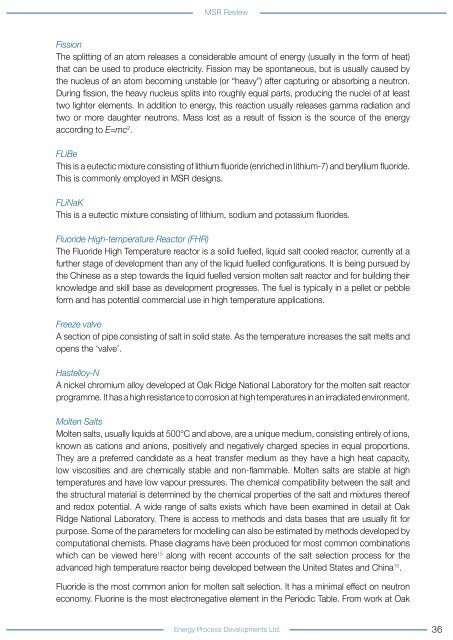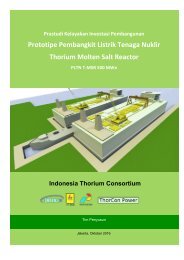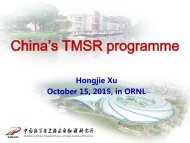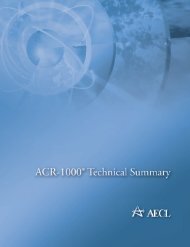MSR Review
EPD MSR Review Feasibility Study July 2015 1.02
EPD MSR Review Feasibility Study July 2015 1.02
You also want an ePaper? Increase the reach of your titles
YUMPU automatically turns print PDFs into web optimized ePapers that Google loves.
<strong>MSR</strong> <strong>Review</strong><br />
Fission<br />
The splitting of an atom releases a considerable amount of energy (usually in the form of heat)<br />
that can be used to produce electricity. Fission may be spontaneous, but is usually caused by<br />
the nucleus of an atom becoming unstable (or “heavy”) after capturing or absorbing a neutron.<br />
During fission, the heavy nucleus splits into roughly equal parts, producing the nuclei of at least<br />
two lighter elements. In addition to energy, this reaction usually releases gamma radiation and<br />
two or more daughter neutrons. Mass lost as a result of fission is the source of the energy<br />
according to E=mc 2 .<br />
FLiBe<br />
This is a eutectic mixture consisting of lithium fluoride (enriched in lithium-7) and beryllium fluoride.<br />
This is commonly employed in <strong>MSR</strong> designs.<br />
FLiNaK<br />
This is a eutectic mixture consisting of lithium, sodium and potassium fluorides.<br />
Fluoride High-temperature Reactor (FHR)<br />
The Fluoride High Temperature reactor is a solid fuelled, liquid salt cooled reactor, currently at a<br />
further stage of development than any of the liquid fuelled configurations. It is being pursued by<br />
the Chinese as a step towards the liquid fuelled version molten salt reactor and for building their<br />
knowledge and skill base as development progresses. The fuel is typically in a pellet or pebble<br />
form and has potential commercial use in high temperature applications.<br />
Freeze valve<br />
A section of pipe consisting of salt in solid state. As the temperature increases the salt melts and<br />
opens the ‘valve’.<br />
Hastelloy-N<br />
A nickel chromium alloy developed at Oak Ridge National Laboratory for the molten salt reactor<br />
programme. It has a high resistance to corrosion at high temperatures in an irradiated environment.<br />
Molten Salts<br />
Molten salts, usually liquids at 500°C and above, are a unique medium, consisting entirely of ions,<br />
known as cations and anions, positively and negatively charged species in equal proportions.<br />
They are a preferred candidate as a heat transfer medium as they have a high heat capacity,<br />
low viscosities and are chemically stable and non-flammable. Molten salts are stable at high<br />
temperatures and have low vapour pressures. The chemical compatibility between the salt and<br />
the structural material is determined by the chemical properties of the salt and mixtures thereof<br />
and redox potential. A wide range of salts exists which have been examined in detail at Oak<br />
Ridge National Laboratory. There is access to methods and data bases that are usually fit for<br />
purpose. Some of the parameters for modelling can also be estimated by methods developed by<br />
computational chemists. Phase diagrams have been produced for most common combinations<br />
which can be viewed here 15 along with recent accounts of the salt selection process for the<br />
advanced high temperature reactor being developed between the United States and China 16 .<br />
Fluoride is the most common anion for molten salt selection. It has a minimal effect on neutron<br />
economy. Fluorine is the most electronegative element in the Periodic Table. From work at Oak<br />
Energy Process Developments Ltd. 36





